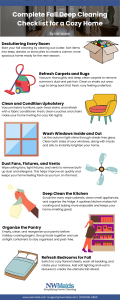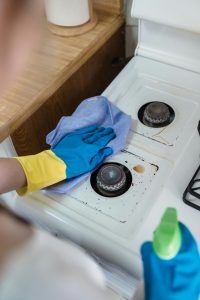When the holidays are over and it’s time to take down the Christmas tree, you’re often left with one frustrating problem — pine needles everywhere.
These tiny, sharp reminders of your festive décor tend to scatter across carpets, rugs, and hardwood floors, making the cleanup after Christmas a challenge.
Luckily, with the right tools and cleaning techniques, you can learn how to clean up pine needles after Christmas quickly and effectively.
Why Cleaning Up Pine Needles After Christmas Matters
Cleaning up pine needles after Christmas isn’t just about keeping things tidy — it’s about protecting your home.
Pine needles can scratch hardwood floors, clog vacuums, and trap moisture, leading to unwanted odors or mold.
Taking time to properly remove Christmas tree needles helps maintain your flooring, preserves your carpets, and ensures your home feels fresh as you head into the new year.
Step-by-Step Guide: How to Clean Up Pine Needles After Christmas
1. Carefully Remove the Christmas Tree
Before you start cleaning up fallen pine needles, remove your Christmas tree carefully to avoid scattering more needles.
Lay down an old sheet or use a Christmas tree disposal bag under the tree stand before moving it.
Wrap the trunk loosely to contain the mess. If your tree is very dry, trim off branches in sections before carrying it outside.
2. Sweep Hard Floors First
For hardwood, tile, or laminate floors, start with a broom or rubber broom instead of a vacuum. Traditional vacuums can get clogged or scratched by dry needles.
Sweep in one direction to gather most of the debris, then use a damp microfiber mop to collect any stragglers.
Rubber brooms are particularly effective since their static charge helps attract and lift stubborn pine needles.
3. Vacuum Pine Needles from Carpets and Rugs
Once your hard surfaces are clean, it’s time to vacuum up pine needles from carpets and area rugs. Use a vacuum with strong suction and no beater brush to prevent tangling.
For edges and corners, use the hose attachment to reach tight spots. Sprinkling baking soda before vacuuming can help loosen needles and neutralize any lingering tree scent.
4. Use Lint Rollers or Tape for Upholstery
Pine needles can cling to furniture, curtains, and even clothing. For these delicate areas, use a lint roller or wrap wide packing tape around your hand (sticky side out).
Gently press the surface to lift pine needles without damaging fabric. Repeat until all visible needles are gone — a quick and easy way to tackle soft surfaces without hauling out the vacuum.
5. Try a Handheld Vacuum for Tight Spaces
A handheld vacuum is ideal for those tricky spots — under couches, between cushions, or along baseboards.
Choose a model with a crevice attachment to get into narrow spaces where pine needles tend to hide. This small but powerful tool can help ensure you’ve removed every last needle.
6. Deep Clean Floors After Needle Removal
After vacuuming and sweeping, finish the job with a deep floor cleaning. For wood floors, use a gentle wood-safe floor cleaner to remove sap residue.
For tile or vinyl, opt for a mild all-purpose cleaner to restore shine. Add a few drops of pine or lemon essential oil to your mop water for a naturally fresh, post-holiday scent.
7. Check HVAC Vents and Air Filters
Pine needles can easily make their way into air vents and filters when you’re removing the tree. Remove vent covers and vacuum inside carefully.
Check and replace HVAC filters if necessary — clean air circulation will help remove any remaining Christmas tree scent and keep your home fresh.
8. Clean Tree Skirts and Storage Areas
Don’t forget to clean your tree skirt, tree stand, and ornament storage bins. Shake off loose pine needles and follow the care instructions on your tree skirt label.
Wipe down storage containers and stands before packing them away. This step helps prevent sap and leftover pine debris from creating a sticky mess next holiday season.
9. Prevent Pine Needle Mess Next Year
Make next year’s cleanup easier by preparing ahead of time. Place a tree disposal bag under your Christmas tree before setting it up.
When the holidays are over, just pull the bag up around the tree for easy removal.
Regular sweeping or vacuuming during the season will also minimize needle buildup. You could even consider switching to an artificial Christmas tree for a no-shed option that’s just as festive.
10. Restore the Freshness of Your Home
Once the pine needles are gone, freshen up your space.
Light a holiday-scented candle, use an air purifier, or spritz a natural room spray to remove any leftover Christmas tree smell.
Opening your windows for a few minutes can also help bring in crisp winter air and leave your home feeling renewed for the new year.
Enjoy a Clean Start to the New Year
Taking down decorations often feels bittersweet, but knowing how to clean up pine needles after Christmas can make the process much easier.
With these simple cleanup steps, your home can be spotless, comfortable, and ready for new beginnings.
If you’d rather skip the hassle of post-holiday cleanup, let NW Maids help.
Our professional cleaning team can handle deep cleaning, organization, and more — giving your home the perfect fresh start for the year ahead.
Conclusion
Pine needles may seem small, but they can create a big mess if not cleaned up properly.
By following these tips for how to clean up pine needles after Christmas, you’ll save time, protect your home surfaces, and enjoy a cleaner, fresher space.
Need extra help restoring order after the holidays?
Contact NW Maids House Cleaning Service today for professional, thorough post-Christmas cleaning services that make your home sparkle again.
Related Posts:
- Stop Winter Mold Before It Starts: Home Protection Guide
- Winter Home Prep Guide: Make Your Home Holiday-Ready
- Complete Fall Deep Cleaning Checklist for a Cozy Home
- How to Clean Windows Without Leaving Streaks
← Cleaning Techniques That Professionals Don’t Always Share
How to Keep Your Home Clean With Pets (Without the Constant Mess) →






























